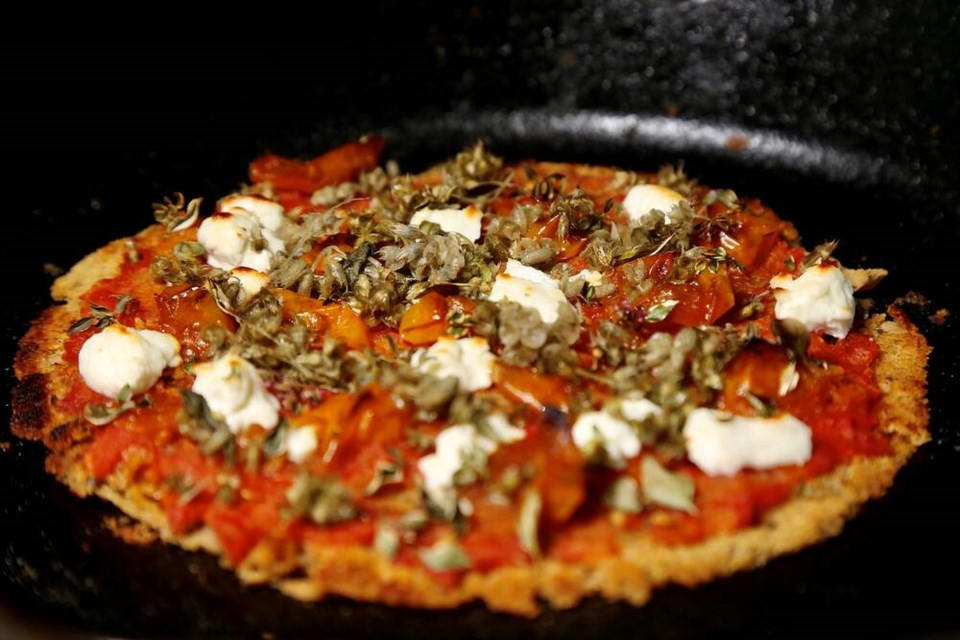Pickling spent herb blossoms to use as elegant condiments is an excellent example of how implementing permaculture principles into daily living illustrates all three of its three overarching ethos of earth care, people care and fair share.
I came across this delectable functional food quite by accident, as a by-product of making basil vinegar from deadheaded holy basil blossoms several years ago. I was experimenting with various herbs like basil, thyme, rosemary, oregano, savory and marjoram – with various vinegars like apple cider, white wine, Champagne and plain Allen’s white.
After six months or so on a shelf in the cool and dark pantry, the vinegars were gorgeous and olfactory bombish. But the flowers, the pickled holy basil blossoms in particular, were a revelation.
We began using the pickled blossoms in place of capers, in everything from salad niçoise to charcuterie, piccatas, potato and egg salad, and as a pizza topping. We gifted small jars at Christmas, and to hosts. The vinegars are heavenly in shrubs, electrolyte recipes, dressings and reductions sauces.
The deadheading and pickling process has become a coveted tradition. During the cool of the morning or evening, an up-ended five-gallon bucket, a large bowl, some snips and I spend a lovely few hours on the patio, navigating the thick understory of holy basil plants that grow beneath trellised tomatoes. Those residents help to keep the soil cool, and ward off predatory pests with their spectacular phytochemical aroma (earth care).
All varieties of basil feature gorgeous long stems of tiny purple or white flowers. Pollinators love the blossoms, so we wait until the bees are done (fair share) and the tiny flowers fall off. While the stems are still green and pliable, but before they dry up, we deadhead them at the junction right above the furthest set of leaves below.
Deadheading forces the plants to produce new growth laterally, and helps the leaves retain vitality and spiciness. We grow our basil, and tomatoes, in three re-purposed livestock feed troughs, under cover of a glass roof. If the planters were exposed to rain and wind, un-trimmed and leggy basil could damage easily.
Herbs and spices are becoming better understood for their powerful food-as-medicine properties. When dried and concentrated, or when used to make an aged decoction with vinegar to extract healing beneficial essences, it is easy for our family to enjoy healthful and delicious benefits all year long (people care).
This year we sourced Champagne vinegar in bulk, for sharing, from Bosa Foods, to make basil vinegar and pickled blossoms. Generally we use raw, unfiltered apple cider vinegar still living at home in the bottle with its “mother.” Raw ACV as it is known in nutrition circles, contains natural probiotics for gut health, antioxidants to help prevent cell damage, and acetic acid which can improve cardiovascular function and kill harmful gut bacteria.
Recently, while experimenting with high protein chickpea flour skillet-pizza crust, we enjoyed last summer’s pickled holy basil blossoms, oven-dried Sungold cherry tomatoes, Saltspring Island goat cheese, and fresh thyme leaves as toppings. The combination was exquisite.
To equal parts water and chickpea flour, I added home-made garlic granules, and in place of salt I added Mermaid Shake – tiny flakes of essential nutrient-dense, air-dried Pacific winged kelp and bull kelp from Dakini Tidal Wilds on Vancouver Island.
The thin pancake batter-like mixture is best managed in a skillet and then finished in the oven once the sauce and toppings have been applied. A single-ingredient sauce of reduced, crushed fresh heirloom tomatoes is all that was needed.
Laura Marie Neubert is a West Vancouver-based urban permaculture designer. Follow her on Instagram @upfrontandbeautiful, learn more about permaculture by visiting her Upfront & Beautiful website or email your questions to her here.
For a taste of permaculture, watch the video below:




